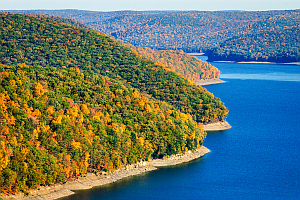Pennsylvania Protects Coldwater Fisheries and Water Quality from Climate Change

In 2009, pursuant to the Pennsylvania Climate Change Act, the Pennsylvania Department of Environmental Protection developed a “Pennsylvania Climate Impact Assessment.” This report identified the climate risks to maintaining the health of freshwater ecosystems among several other climate vulnerabilities.
The report identified warmer air temperatures, and the associated increase of stream waters, may reduce the ability for certain aquatic species to survive. This is supported by the EPA National Water Program's Climate and Water Strategy which identifies cold water fisheries as particularly susceptible to environmental changes and associated changes in water temperature.
The Climate Impact Assessment specifically suggested that: “Pennsylvania may see a decline in some of our most valued coldwater communities…Of special concern is the impact of higher temperatures and altered flow regimes on Eastern Brook Trout, not only because of its status as a recreationally and culturally important species, but because it is an indicator of high water quality and may be an early victim of deleterious impacts of climate change.”
Pennsylvania recognized the cultural, environmental, and economic importance of coldwater fisheries to the state. With the identified vulnerability of possible transformation of coldwater fisheries to warmwater fisheries, Pennsylvania's Climate Change Adaptation Report that discussed projected impacts and potential adaptation strategies regarding stream health. Since launching its first report in 2009, Pennsylvania has issued several updates that each address stream health and various stressors and impacts due to a changing climate.
The need to develop and implement adaptation strategies to the changes in the environment and protect coldwater fisheries and freshwater ecosystems were specifically addressed within Pennsylvania's 2009 Climate Adaptation Planning Report and in each subsequent report that has been released.
These strategies, if implemented, can help Pennsylvania adapt to future changes to freshwater ecosystems. Coldwater fisheries and overall stream health will benefit from these strategies regardless of whether future climatic impacts meet or exceed current projections.
| How Did They Do It? | Applicable EPA Tools |
|---|---|
Pennsylvania conducted a Vulnerability Assessment for their natural lands
| Hydrologic and Water Quality System (HAWQS) models seven categories of pollutants to estimate future impacts of climate change on water quality and inform vulnerability assessments. |
Developed a Climate Adaptation Report
| Adaptation to Attain Clean Water Goals can inform an adaptation report by discussing how climate change may affect the ability to meet future goals of the Clean Water Act. |
Identified specific recommendations
| Synthesis of Adaptation Strategies Guidebook Wildlife Adaptation Strategy (PDF)(120 pp, 3.8 MB, About PDF) |
Similar Cases and More Information
To view another case(s) that works to protect water quality and fish habitat, view the Piscataqua National Estuary Program or Minnehaha River case. For more information on communities that have adapted to maintain healthy streams for aquatic organisms under changing climate conditions view Vermont Culvert Rebuild Policy, or the Maine Culvert Analysis Case.
References
- Pennsylvania Climate Impact Assessment Reports to the Department of Environmental Protection (2009)
- 2015 Pennsylvania Climate Impacts Assessment Update (PDF) (199 PP, 10.2 MB)
- 2020 Pennsylvania Climate Impacts Assessment Update (PDF) (143 PP, 6.4 MB)
- 2021 Pennsylvania Climate Impacts Assessment Update (PDF) (143 PP, 6.4 MB)
- Climate Impacts: A Changing Pennsylvania (PDF Factsheet) (2 pp, 969 KB)
- Pennsylvania Climate Action Plan
- Planning and Management: Programmatic Response to Climate Change and Water
